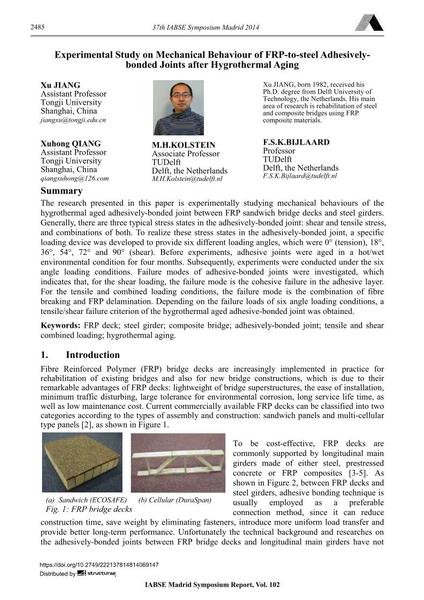Experimental Study on Mechanical Behaviour of FRP-to-steel Adhesively- bonded Joints after Hygrothermal Aging

|
|
|||||||||||
Détails bibliographiques
| Auteur(s): |
Xu Jiang
Xuhong Qiang M. H. Kolstein F. S. K. Bijlaard |
||||
|---|---|---|---|---|---|
| Médium: | papier de conférence | ||||
| Langue(s): | anglais | ||||
| Conférence: | IABSE Symposium: Engineering for Progress, Nature and People, Madrid, Spain, 3-5 September 2014 | ||||
| Publié dans: | IABSE Symposium Madrid 2014 | ||||
|
|||||
| Page(s): | 2485-2492 | ||||
| Nombre total de pages (du PDF): | 8 | ||||
| Année: | 2014 | ||||
| DOI: | 10.2749/222137814814069147 | ||||
| Abstrait: |
The research presented in this paper is experimentally studying mechanical behaviours of the hygrothermal aged adhesively-bonded joint between FRP sandwich bridge decks and steel girders. Generally, there are three typical stress states in the adhesively-bonded joint: shear and tensile stress, and combinations of both. To realize these stress states in the adhesively-bonded joint, a specific loading device was developed to provide six different loading angles, which were 0° (tension), 18°, 36°, 54°, 72° and 90° (shear). Before experiments, adhesive joints were aged in a hot/wet environmental condition for four months. Subsequently, experiments were conducted under the six angle loading conditions. Failure modes of adhesive-bonded joints were investigated, which indicates that, for the shear loading, the failure mode is the cohesive failure in the adhesive layer. For the tensile and combined loading conditions, the failure mode is the combination of fibre breaking and FRP delamination. Depending on the failure loads of six angle loading conditions, a tensile/shear failure criterion of the hygrothermal aged adhesive-bonded joint was obtained. |
||||
| Mots-clé: |
pont mixte
|
||||
